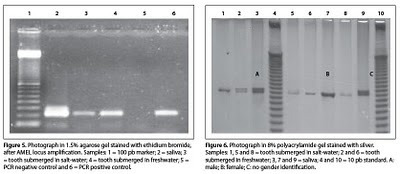Odontologia

Author: [email protected]
- The Chronology Of Second Molar Development In Brazilians And Its Application To Forensic Age Estimation
AbstractPurpose: This study investigated the possible correlation between the mineralization of the second molars and the chronological age of a sample population of the state of Paraiba, Brazil. Materials and Methods: One thousand eight hundred...
- Human Identification Analysis Using Pcr From The Root Portion Of Dental Elements Under Different Conditions Of Temperature And Exposure Time
AbstractIntroduction and objective: The main exogenous factors limiting the retrieval of information from human remains are fire and accidents involving high temperatures. Teeth, due to their relatively high degree of chemical and physical resistance,...
- Association Between Mineralization Of Third Molars And Chronological Age In A Brazilian Sample
AbstractPurpose: To evaluate the association between chronological age and mineralization of third molar teeth in a sample from the Northeast region of Brazil. Methods: A sample of 173 digitized panoramic radiographs were selected from a total of 2,442...
- Forensic Anthropology And Molecular Biology: Independent Or Complementary Sciences In Forensic Dentistry? An Overview
AbstractHuman identification is currently one of the most outstanding areas of Forensic Sciences. Forensic anthropology is a branch of the Forensic Sciences concerned with the application of general anthropological knowledge and methods to the process...
- Genetics And Molecular Biology: A Literature Review Of Forensic Dentistry Application
AbstractForensic expertise methodology normally used in different criminal investigation and forensic medicine field such as blood type, anthropologic analysis and forensic dentistry (dental records, X-rays, bite marks, among others) solved and will...
Odontologia
Freshwater and salt-water influence in human identification by analysis of DNA: an epidemiologic and laboratory study*
*Influência da água doce e da água salgada na identificação humana pela análise do DNA: um estudo epidemiológico e laboratorial.
Abstract
Aim: To investigate the casuistry of drowning cases by reviewing the records from the Forensic Medicine Institute Nina Rodrigues in the city of Salvador, BA, Brazil, and to verify the potential of DNA recovery in human teeth immersed in water. Methods: An epidemiological survey was conducted followed by a laboratorial phase, in which 40 teeth were immersed in fresh and salt-water, the DNA was extracted by the organic method and amplified by polymerase chain reaction, using the amelogenin as initiator. The electrophoresis initially occurred in agarose gel and later in polyacrylamide gel. Results: In the present survey, 346 deaths from drowning were observed, most of them in salt-water (51.73%), with a predominance of male victims (86.13%) aged from 18 to 35 years-old (37.94%). Dentists identified 14.74% of the victims. DNA was recovered in 37.5% from the samples, most from teeth immersed in freshwater. Polyacrylamide gel analysis in samples that were amplified in agarose gel allowed correct gender identification in 83.3% of the cases. However, allele loss was observed in samples of two victims, jeopardizing gender determination. Conclusions: Dental exposure to water interfered in DNA recovery. The gender investigation using the amelogenin as initiator was effective. Published in Brazilian Journal of Oral Sciences April/June 2009 - Volume 8, Number 2.
Download full text (baixar texto completo)Author: [email protected]
loading...
- The Chronology Of Second Molar Development In Brazilians And Its Application To Forensic Age Estimation
AbstractPurpose: This study investigated the possible correlation between the mineralization of the second molars and the chronological age of a sample population of the state of Paraiba, Brazil. Materials and Methods: One thousand eight hundred...
- Human Identification Analysis Using Pcr From The Root Portion Of Dental Elements Under Different Conditions Of Temperature And Exposure Time
AbstractIntroduction and objective: The main exogenous factors limiting the retrieval of information from human remains are fire and accidents involving high temperatures. Teeth, due to their relatively high degree of chemical and physical resistance,...
- Association Between Mineralization Of Third Molars And Chronological Age In A Brazilian Sample
AbstractPurpose: To evaluate the association between chronological age and mineralization of third molar teeth in a sample from the Northeast region of Brazil. Methods: A sample of 173 digitized panoramic radiographs were selected from a total of 2,442...
- Forensic Anthropology And Molecular Biology: Independent Or Complementary Sciences In Forensic Dentistry? An Overview
AbstractHuman identification is currently one of the most outstanding areas of Forensic Sciences. Forensic anthropology is a branch of the Forensic Sciences concerned with the application of general anthropological knowledge and methods to the process...
- Genetics And Molecular Biology: A Literature Review Of Forensic Dentistry Application
AbstractForensic expertise methodology normally used in different criminal investigation and forensic medicine field such as blood type, anthropologic analysis and forensic dentistry (dental records, X-rays, bite marks, among others) solved and will...
